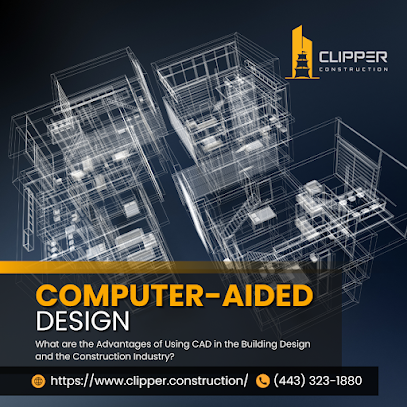What are the Advantages of Using CAD in the Building Design and the Construction Industry?
In today's fast-paced world, technology has transformed
almost every aspect of our lives, and the field of architecture and
construction is no exception. Computer-Aided Design (CAD) has revolutionized
the way buildings are designed, planned, and constructed. Gone are the days of
manual drafting and tedious calculations; CAD software has become an
indispensable tool for architects, engineers, and construction professionals.
In this blog post, we will explore the numerous advantages of using CAD in
building design and the construction industry, from enhanced design and
visualization to increased efficiency, cost savings, improved collaboration,
and beyond.
What is
Computer-Aided Design (CAD)?
Computer-Aided Design (CAD) is a powerful and versatile technology that has revolutionized the way professionals in the architecture, engineering, and construction industries design and create various projects. CAD is a digital software tool that allows users to create precise and detailed 2D and 3D models of buildings, products, or mechanical components. It enables architects, engineers, and designers to draft, visualize, and simulate their ideas in a virtual environment, leading to more efficient and accurate designs.
CAD provides a wide range of benefits, including enhanced
design capabilities, streamlined workflows, and improved collaboration among
project teams. With CAD, designers can easily experiment with different design
options, make quick changes, and create realistic visualizations of the final
product. The software also automates repetitive tasks, saving time and reducing
the risk of errors in the design process. Additionally, CAD facilitates
seamless collaboration by allowing multiple team members to work on the same
project simultaneously, promoting efficient communication and coordination.
Computer-aided design (CAD) is a sophisticated digital tool
that empowers professionals in various industries to create detailed and
precise 2D and 3D models of their designs. Through its features and
capabilities, CAD enhances design efficiency, fosters better communication
among team members, and ultimately contributes to the creation of innovative
and successful projects.
Enhanced Design and
Visualization
One of the most significant advantages of CAD is its ability
to create both 2D and 3D models of buildings. These digital representations
offer a level of detail and precision that traditional blueprints simply cannot
match. With CAD, architects and designers can visualize their ideas in a
realistic manner, enabling clients and stakeholders to better understand the
proposed designs.
Moreover, CAD software allows for the creation of stunning
renderings and virtual walkthroughs, giving clients a virtual tour of their
future buildings. This immersive experience helps clients make informed
decisions about the design and make necessary adjustments early in the process.
Additionally, CAD's rapid prototyping capabilities enable quick design
iterations, saving time and resources during the creative phase.
Increased Efficiency
and Accuracy
CAD's automation features streamline the design process and
significantly reduce the risk of human errors. Tasks that would take hours or
even days to complete manually can now be done with a few clicks. For instance,
CAD can generate floor plans, elevations, and sections automatically, saving
architects valuable time. This efficiency boost not only expedites the design
phase but also improves overall project timelines.
The accuracy of CAD software ensures that designs and
construction documents are error-free, reducing costly mistakes during
construction. Engineers can perform complex calculations with precision,
leading to structurally sound buildings. Moreover, CAD's version control
capabilities help maintain a clear record of design changes and updates,
eliminating confusion during project coordination.
Cost and Time Savings
Implementing CAD in the building design and construction
industry offers significant cost and time savings. CAD facilitates optimized
material usage and waste reduction. By accurately calculating the required
materials, construction teams can order the exact quantities needed, minimizing
excess and avoiding costly overruns.
Additionally, CAD's efficiency and accuracy lead to faster
project completion. The streamlined workflows and automation features enable
professionals to meet deadlines more effectively. The reduced project duration
translates to lower labor costs and overhead expenses.
Furthermore, CAD reduces the number of design and
construction revisions needed. With a more comprehensive and realistic
representation of the building in the early stages, design errors can be
detected and rectified before construction commences. This minimizes costly
on-site modifications and change orders, ultimately saving resources for all
stakeholders.
Improved
Collaboration and Communication
CAD fosters enhanced collaboration among architects,
engineers, and contractors. These professionals can work simultaneously on the
same digital model, allowing real-time feedback and modifications. This collaborative
approach ensures that all parties are aligned with the design intent and
minimizes conflicts during the construction phase.
Moreover, CAD integrates seamlessly with other project
management tools, such as Building Information Modeling (BIM) software,
facilitating efficient data sharing and coordination. This integration enables
better communication between design teams and construction crews, leading to
smoother project execution.
CAD's visual capabilities enhance communication with clients
and stakeholders. Complex design concepts can be presented visually, making it
easier for non-technical individuals to comprehend and provide feedback. This
improves client engagement and satisfaction throughout the project.
Sustainable Design
and Analysis
The importance of sustainable design has grown significantly
in recent years, and CAD plays a vital role in this aspect. CAD software allows
architects and engineers to perform energy-efficient building simulations,
evaluating different design options to identify the most environmentally
friendly solutions.
Additionally, CAD facilitates the evaluation and selection
of eco-friendly materials, considering factors such as recyclability, energy
consumption, and carbon footprint. This supports sustainable building practices
and can contribute to achieving green building certifications, such as LEED
(Leadership in Energy and Environmental Design).
Safety and Risk
Mitigation
Safety is of paramount importance in the construction
industry, and CAD helps address potential hazards during the design phase.
Through simulations and clash detection, CAD software identifies and rectifies
design conflicts that could pose safety risks during construction.
Moreover, CAD ensures compliance with building codes and
regulations, reducing the risk of non-compliance penalties and rework. With
accurate documentation and adherence to standards, construction projects can
proceed with confidence, ensuring the safety of workers and occupants alike.
Adaptation to
Technological Advancements
CAD is a dynamic field that continues to evolve alongside
technological advancements. Integrating CAD with emerging technologies like
Artificial Intelligence (AI), Virtual Reality (VR), and Augmented Reality (AR)
opens up new possibilities for design exploration and project visualization.
Cloud-based CAD solutions enable seamless collaboration
among geographically dispersed teams, breaking down barriers to communication
and improving project efficiency. As technology continues to advance, CAD will
play a pivotal role in the future of building design and construction.
Challenges and
Limitations
While the advantages of CAD are substantial, it's essential
to acknowledge the challenges and limitations that come with its
implementation. Initial costs, such as software licenses and training, may be a
barrier for some firms. Adequate training and ongoing support are crucial to
maximize the potential of CAD software and ensure its proper usage.
Additionally, software compatibility and interoperability
between different CAD platforms can be a concern, especially when multiple
stakeholders are involved in a project. Balancing the automation capabilities
of CAD with human creativity and intuition is also a delicate challenge, as the
human touch remains indispensable in architectural and engineering design.
Conclusion
In conclusion, the advantages of using CAD in building
design and the construction industry are undeniable. From enhanced design and
visualization to increased efficiency, cost savings, improved collaboration,
and sustainable practices, CAD has transformed the way we create and construct
buildings.
With CAD's continuous evolution and integration with
emerging technologies, the future looks promising for the architecture,
engineering, and construction sectors. Embracing CAD technology allows
professionals to deliver better-designed buildings, reduce project timelines,
and foster more productive collaboration, ultimately enhancing the built
environment for generations to come.

